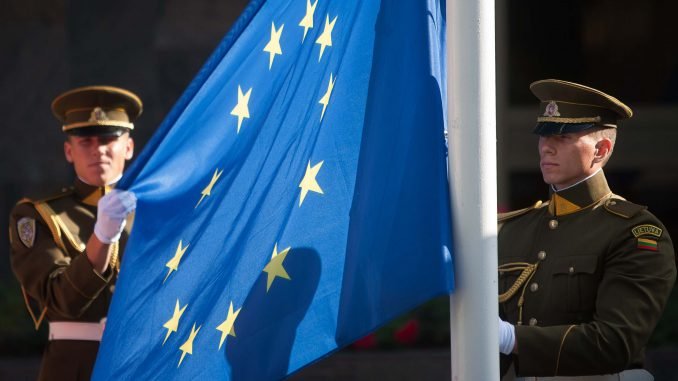
Already a few weeks ago, from moods in the financial markets, it could be predicted that the EU stimulus plan will be approved. Just there were questions on its nuances: how much funding will be distributed via loans and how much – through subsidies, SME Finance economist Aleksandras Izgorodinas believes, Simona Viltrakytė wrote in lrytas.lt
“The thrifty countries won the battle – more funding will be released through loans. However, looking fundamentally, there was no risk that the plan would not be approved because the EU countries will begin reducing their domestic economic stimulus measures in autumn. This is because most EU countries applied short term stimulus measures, which were oriented at softening the impact of the first wave. Furthermore, funding for several measures is running out. Meanwhile, the EU’s economy is so weak that lacking further fundamental EU stimulus plan, it will not survive,” the economist mused.

Furthermore, according to him, this is not the last EU stimulus plan that the EU will come to terms on. This is because it does not fully resolve two key problems – company and consumer expectations in the Eurozone.
“It is excellent that the markets will contain a great deal of money, however the risk emerges that only a very small portion of it will enter the economy. I make this assumption because in May, the annual deposit remnants of Eurozone residents – compared to May 2019 – rose by 6.4%. This is the largest increase since February 2009. This means that upon receiving stimulus funding, people deposited it into their accounts rather than spending.
The current stimulus plan does not resolve this problem – in order for consumers to begin more rapidly spending, a vaccine is necessary, which would allow knowing whether the problem has been resolved.
I personally found measures such as those employed in China to be lacking, where vouchers were distributed rather than funds into bank accounts,” A. Izgorodinas told the lrytas.lt news portal.
He also highlighted business expectations. As it is very likely that the EU’s economic recovery will not be particularly rapid, companies in the EU will not be in a hurry to create new jobs. This will lead to a situation where the GDP grows, but new jobs are not created. According to the commentator, while company expectations are cautious and they are such because of a looming potential second wave of the coronavirus, they will not be in a hurry to create new jobs despite there being ample stimulus funding.
“It could be that in the future, the European Commission will venture to employ down to earth measures, not innovative ones. An example could be the distribution of vouchers, which would help kickstart consumption,” the economist mused.
According to him, the EU has achieved agreement on rescue funding, but this does not mean that Lithuania will be able to spend at will the funding it receives.
“We will not have a great deal of room to manoeuvre in terms of absorbing the funding – several areas will be financed in particular: digitisation, innovations and green energy. These are very specific reform domains, which countries will have to implement and where they will be thoroughly accountable to the EU.
In this plan, I see only one opportunity for Lithuania. As a significant amount of funding will be received via soft loans, this could help resolve the problem of business financing. In May, based on bank loan for businesses dynamics, Lithuania was the last in the Eurozone. Compared to May 2019, bank loans to companies fell by around 7.5%.
The state could take a loan from the EC and re-loan the funds or release through alternative financers buying its obligations, or by establishing joint public-private funds. This would be a far more effective solution than establishing a state bank,” A. Izgorodinas stated.
A billion less
Economist Nerijus Mačiulis says that in the European Council, Lithuania lost the most in negotiations on the European recovery and resilience fund. However, together with the other Baltic States, it won out in the negotiations on greater funding for agriculture.
“It is around a billion less than outlined in the primary plan prior to the negotiations. Lithuania lost out the most in the EU stimulus plan where previously, 3.9 billion euro in subsidies was allocated to Lithuania, but now this fell to 2.4 billion euro. There is more opportunity for borrowing.
This is probably not a consequence of a weak negotiation position by Lithuania, just the result of stronger negotiations by the thrifty four EU countries – the Netherlands, Sweden, Denmark and Austria because they did not want for the fund to release too much in repayment-free funds, instead expanding the fund’s borrowing potential more, while significantly cutting opportunities to obtain return-free grants,” N. Mačiulis told the ELTA news agency.
According to him, this was the largest shift in the entire negotiatory process.
“Everywhere else we have symbolic, smaller changes. One of the results, which was received as compensation by all the poorer EU countries, is that they will see increased grants for farmers and greater financing for the agricultural sector. This is the win for the Baltic States,” the economist said.
Lithuania will be able to borrow up to 4.7% of its GDP from the Recovery and Resilience Facility or 2.2 billion euro for implementing reforms. Whether it will be worth borrowing will depend, according to N. Mačiulis, on what the borrowing interest rates will be.
“In any case, Lithuania will now be forced to borrow and is namely planning to borrow in the international financial markets. This should be carefully weighed and not too much should be borrowed in the financial markets because it is likely that by borrowing from the EU Recovery and Resilience Facility, the conditions will be better than when borrowing on the financial markets. I believe that there will be no stigma for borrowing from the fund because, after all, the funds are intended to combat the pandemic,” the economist said.
According to him, borrowing from the Recovery and Resilience Facility should not be viewed with any preconceptions, but neither should fiscal and economic stimulus be overly accelerated because it has negative side effects.
According to the economist, Lithuania should only borrow to the extent that it needs to patch the holes in this year’s budget.
“Lithuania is one of the fastest recovering countries and it has faced among the least economic consequences. It is probably a correct strategy to borrow only to the extent of covering this year’s budget deficit, in line with where tax revenue does not suffice. Meanwhile, economic stimulus, recovery and restructuring should be performed on the basis of return-free EU subsidies,” N. Mačiulis said.
According to him, the EU stimulus plan should be directed not only to short term economic stimulus where jobs are created because, as he notes, but this also does not lead to long term economic growth potential.
“Most of this funding should be directed toward what increases the country’s productivity, competitiveness and what is outlined in the EU rescue and support fund terms of use, with around a third of the funding to be used to achieve the Paris Climate Accord goals on reducing the consequences of climate change, reducing CO2 emissions and incentivising the use of renewable energy. More opportunities emerge here to create a greener and more sustainable economy while safeguarding the environment,” N. Mačiulis spoke.
Generous EU subsidies will have to be used suitably
After the EU leaders reached final agreement on Tuesday night on the economic recovery fund and the new EU budget, economist Žygimantas Mauricas says that the country is to receive a sufficiently generous subsidy. Nevertheless, it must be used appropriately, investing in projects that would yield high economic returns.
The combined European support for Lithuania in the new Financial Framework is to reach 14.5 billion euro, which is 1.7 billion euro more than in 2014-2020. Furthermore, from the new EU recovery fund, Lithuania is to receive 2.4 billion euro in subsidies and 3 billion euro in loans.
According to the economist, the EU has displayed a gesture of solidarity in this difficult period and ensured that talks about a potential collapse of the union should calm for the near future.
“This is perhaps the best news for Lithuania because it is a small, open and dependent on export markets economy. Namely this aspect, even if less emphasised, is of most importance for Lithuania,” Ž. Mauricas told the BNS news agency.
“Upon receiving this candy, both Italy and Spain, as well as other Southern European countries will be more positively inclined toward the EU and conditions, which might leave to certain countries departing the union, will not be strengthened. The risk will be reduced. As the plan is fairly long term, it is a very positive signal for the EU’s unity,” he added.
According to Ž. Mauricas, the greatest challenge for Lithuania will be adequate use of the support – the country should encourage investment attraction in industry, invest in climate-neutral and digital economy incentivisation.
“As most economic superpowers, the EU is seeking to attract as much as possible manufacturing and other economic activities to its territory, this particularly being the case with growing uncertainty between the US and China. This is an excellent opportunity for Lithuania and the entire region to attract investment, particularly in the industrial sector.
The first priority should be allocating funds to attract investment: preparing infrastructure, financing free economic zones, industrial parks and research,” the economist said.
According to Ž. Mauricas, with the EU transitioning to a climate neutral economy by 2050, Lithuania should continue in this direction, starting from apartment building insulation, finishing with investment in biofuels and solar energy.
Lithuania can borrow up to 3 billion euro from the recovery fund, however Ž. Mauricas says that it is not worth borrowing. According to him, given an excess of funds, the risk emerges that it may be used inefficiently.
“We could cause a short term bubble and after seven years, be left empty-handed. There should always be a lack of funds because this leads to more effective decision making and if an understanding emerges that this is excess funding, shovelling of funds left and right begins, which never ends well,” he said.
Five days of negotiations
As a reminder, on Tuesday morning, after five days of discussions, the final stage of negotiations on the EU’s Multi-annual Financial Framework and the European Recovery and Resilience Facility, intended for combatting the coronavirus pandemic’s consequences, was concluded.
Compared to the previous Financial Framework, for 2021-2027, Lithuania managed to negotiate an extra 1.7 billion euro, reaching a combined EU allocation to Lithuania of 14.5 billion euro.
For implementing cohesion policy, Lithuania is to be granted 6.2 billion euro. For financing agriculture, a total of 5 billion euro was allocated.
The EU has earmarked 490 million euro for the Ignalina NPP closure project and 189 million euro financing for the Kaliningrad special transit scheme. The development of Rail Baltica was issued a further sum of 1.4 billion euro. Attention has remained on military mobility, which sees 1.5 billion euro financing allocated.
The president of Lithuania has said that EU heads of state have agreed on a combined EU response to the pandemic-caused healthcare, social and economic crisis. For this purpose, an EU Recovery and Resilience Facility is being created, in which Lithuania is allocated 2.4 billion euro.
The head of state noted that if need be, Lithuania could also borrow from the Recovery and Resilience Facility for up to 4.7% of its GDP or 2.2 billion euro in order to implement reforms.


Be the first to comment